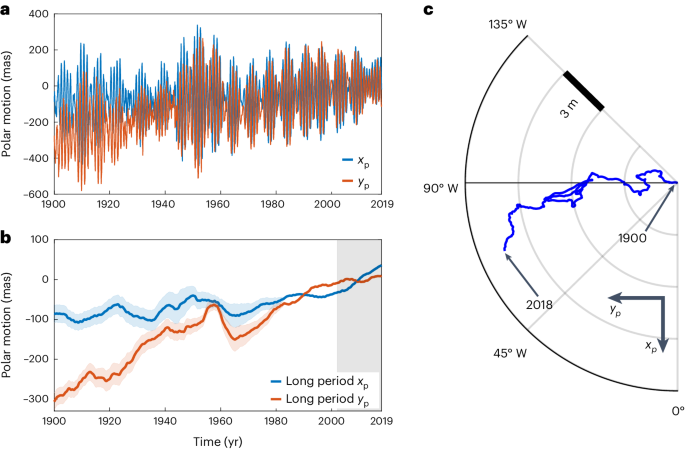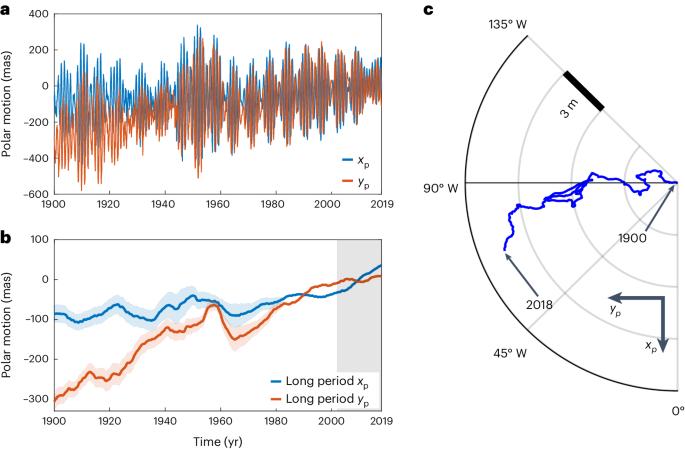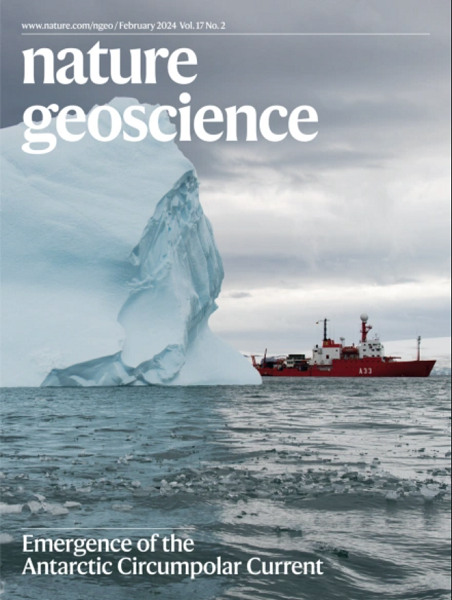地核、地幔和气候过程对地球极地运动的贡献
IF 15.7
1区 地球科学
Q1 GEOSCIENCES, MULTIDISCIPLINARY
引用次数: 0
摘要
随着时间的推移,地球自转轴相对于地壳缓慢移动。通过天文测量和更现代的大地测量所获得的长达 120 年的极地运动记录显示,在每年约 3 毫秒的世俗趋势上叠加了 20 至 40 毫秒的年际和十年期波动。地球的极地运动被认为是由各种地表和内部过程驱动的,但这些过程如何运作和相互作用以产生观测到的信号仍然是个谜。在这里,我们展示了根据地球物理过程的测量结果训练的物理信息神经网络集合所做的预测,可以解释观测到的极地运动的主要特征。我们发现,冰川等静力调整和地幔对流是造成极地运动趋势的主要原因。地球表面的质量再分布--例如冰融化和全球储水量的变化--产生了相对较弱的趋势,但解释了约 90% 的年际和多年代变化。我们还发现,地核过程对极地运动的世俗趋势和波动都有贡献,这可能是由于地核-地幔边界的力矩变化,也可能是地核对地表质量变化的动态反馈。我们的研究结果为过去一个世纪中很少观测到的地核-地幔相互作用和全球冰质量平衡提供了制约因素,并表明与气候有关的地表过程和地核动力学之间存在反馈作用。本文章由计算机程序翻译,如有差异,请以英文原文为准。


Contributions of core, mantle and climatological processes to Earth’s polar motion
Earth’s spin axis slowly moves relative to the crust over time. A 120-year-long record of this polar motion from astronomical and more modern geodetic measurements displays interannual and multidecadal fluctuations of 20 to 40 milliarcseconds superimposed on a secular trend of about 3 milliarcseconds per year. Earth’s polar motion is thought to be driven by various surface and interior processes, but how these processes operate and interact to produce the observed signal remains enigmatic. Here we show that predictions made by an ensemble of physics-informed neural networks trained on measurements to capture geophysical processes can explain the main features of the observed polar motion. We find that glacial isostatic adjustment and mantle convection primarily account for the secular trend. Mass redistribution on the Earth’s surface—for example, ice melting and global changes in water storage—yields a relatively weak trend but explains about 90% of the interannual and multidecadal variations. We also find that core processes contribute to both the secular trend and fluctuations in polar motion, either due to variations in torque at the core–mantle boundary or dynamical feedback of the core in response to surface mass changes. Our findings provide constraints on core–mantle interactions for which observations are rare and global ice mass balance over the past century and suggest feedback operating between climate-related surface processes and core dynamics. Core processes, dynamically linked to mantle and climate-related surface processes, contribute to both the long-term trend and shorter-term fluctuations observed in Earth’s polar motion, according to predictions from physics-informed neural networks.
求助全文
通过发布文献求助,成功后即可免费获取论文全文。
去求助
来源期刊

Nature Geoscience
地学-地球科学综合
CiteScore
26.70
自引率
1.60%
发文量
187
审稿时长
3.3 months
期刊介绍:
Nature Geoscience is a monthly interdisciplinary journal that gathers top-tier research spanning Earth Sciences and related fields.
The journal covers all geoscience disciplines, including fieldwork, modeling, and theoretical studies.
Topics include atmospheric science, biogeochemistry, climate science, geobiology, geochemistry, geoinformatics, remote sensing, geology, geomagnetism, paleomagnetism, geomorphology, geophysics, glaciology, hydrology, limnology, mineralogy, oceanography, paleontology, paleoclimatology, paleoceanography, petrology, planetary science, seismology, space physics, tectonics, and volcanology.
Nature Geoscience upholds its commitment to publishing significant, high-quality Earth Sciences research through fair, rapid, and rigorous peer review, overseen by a team of full-time professional editors.
 求助内容:
求助内容: 应助结果提醒方式:
应助结果提醒方式:


